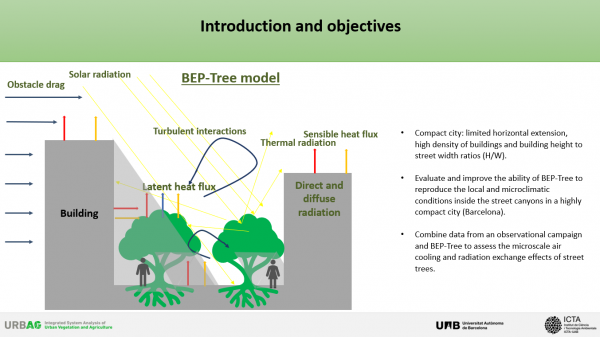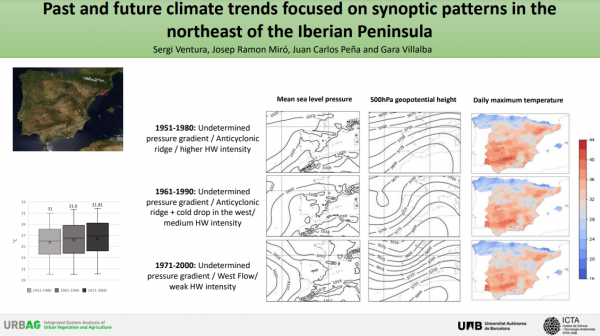URBAG participation at EGU22
3 June 2022
Two presentations from URBAG members have been shared in the latest EGU’s annual General Assembly EGU22, hosted in Vienna, Austria. Thanks to the hybrid format, over 14,000 attendees from 116 countries have shared each work throughout the week-long conference from 23-27 May 2022.
The following URBAG presentations have followed the platform for early-career scientists (ECS). The first one, presented by Ricard Segura, has been carried out in the session “Promoting and supporting equality, diversity and inclusion in the geosciences”. The second one, presented by Sergi Ventura, was carried out in the session “Urban climate, urban biometeorology, and science tools for cities”.
Presentation 1 by Ricard Segura et al.:
Street trees can play an important role in the greening strategies of high-compact cities, defined as cities with limited horizontal extension and high building density, such as Barcelona city. The Building Effect Parameterization with Trees or BEP-Tree is a multi-layer urban canopy model that accounts for the integrated effects of street trees on the neighborhood-scale climate, in terms of radiation exchange, energy balance, wind drag and turbulence. Although this model has been thoroughly evaluated via comparison against measurement datasets, it has only been tested for open lowrise residential neighborhoods, but not in compact dense areas. The main goal of this study is to evaluate and improve the ability of BEP-Tree to represent the local microclimatic conditions inside the street canyons of a highly compact city such as Barcelona; and to combine data from an observational campaign and numerical results to assess the microscale air cooling and radiation exchange effects of street trees in this kind of cities.
If you are interested in reading the abstract, please follow this link.
Presentation 2 by Sergi Ventura et al.:
Heat waves (HWs), which are extremely warm episodes that reach 95th percentile of summer temperatures during three or more consecutive days, are expected to increase both in intensity and duration in the next decades. The main objective of this work is to focus in HWs, but not only in terms of temperature but also in terms of synoptic and mesoscale structure with the objective of further analyse the recent past possible evolution in a Climate Change context and also the possible future trends thanks to the regional climate models selected from CORDEX. For that, Principal Component Analysis (PCA) has been applyied to multiple historical (reanalysis and CORDEX) and future (CORDEX scenarios 4.5 and 8.5) potential HW episodes, considering sea surface level pressure and 500hPa geopotential height. This PCA aims to reduce the dimensionality of the input, explaining the maximum amount of variance with as minimum PC as possible, increasing interpretability but also minimizing information loss. The charts obtained from this methodology have been classified following an objective classification from Miró et al. (2020). First conclusions indicate that no important atmospheric structure changes are expected. Even though, it is forecasted an increase of geopotential height at 500hPa, specially in scenario 8.5. This fact could increase the intensity of anticyclonic ridges, which are the warmest HW structures.
If you are interested in reading the abstract, please follow this link.

